J. Ritchie Patterson and Joan Curtiss, Cornell University
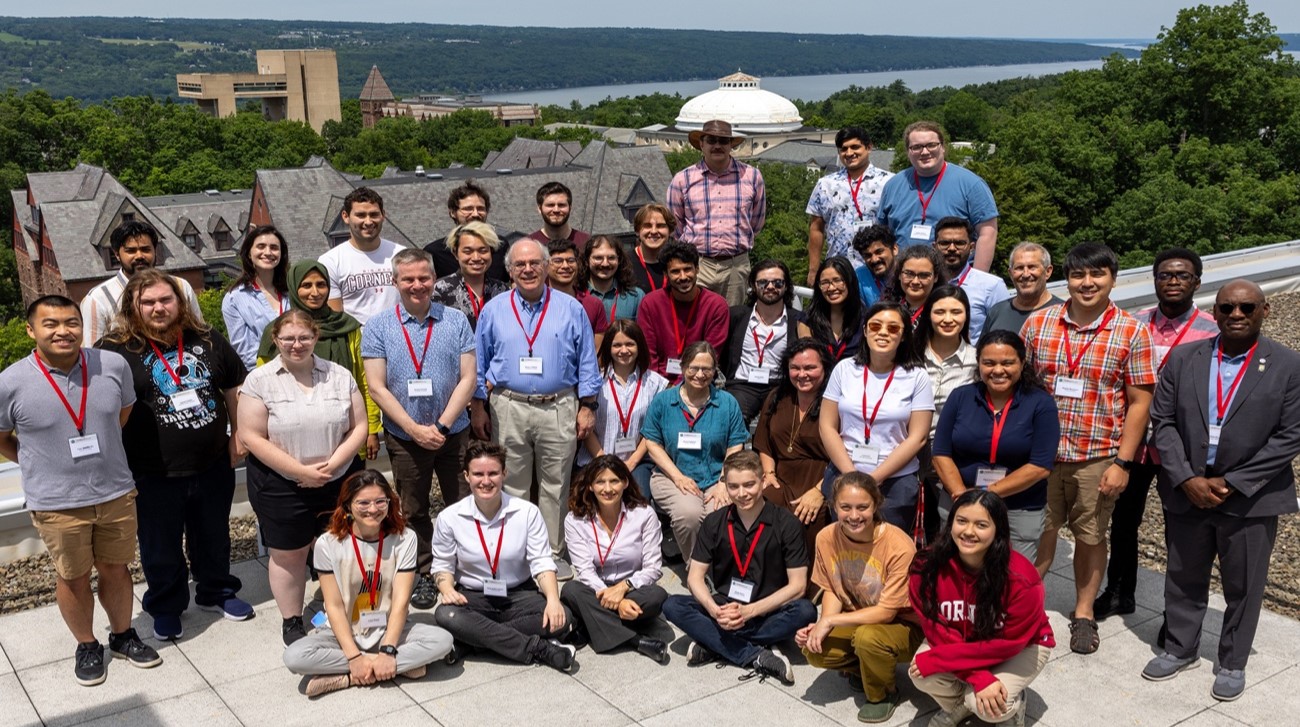 Center for Bright Beams Team
Center for Bright Beams Team
Since its inception in 2016, the Center for Bright Beams (CBB) has been advancing accelerator capabilities and training the next generation of accelerator scientists. Supported by the National Science Foundation as a Science and Technology Center, CBB joins an interdisciplinary team of scientists from Arizona State University, Brigham Young University, University of Chicago, Cornell University (lead), UCLA, University of Florida, University of New Mexico, Northern Illinois University and the national laboratories SLAC, Fermilab and Berkeley Lab.
CBB graduate student and post-doc education addresses a pressing shortage of accelerator scientists. There is a growing demand for experts who can design and build accelerators for a wide range of applications — from large particle colliders and advanced x-ray light sources to beamlines for electron imaging, medical treatments and semiconductor manufacturing — yet only a few universities offer graduate education in this field. To date, CBB has successfully trained 61 doctoral students and postdocs in accelerator science and related disciplines, and 30 more are in the pipeline. In addition, 113 undergraduates have contributed to CBB research, and many of these students are choosing careers in accelerator science.
CBB supplements traditional graduate education with professional development and practices that promote collaboration and communication. Many of these cohort-building practices originate from the demands of CBB research (see insets), which is highly interdisciplinary and is conducted by a team that spans from shore to shore. These practices have proven particularly beneficial for graduate students and postdocs, who experience a deeply supportive, collaborative community that prepares them well for their careers. Many of these methods are adaptable to other university programs and DOE laboratory teams. We outline some of CBB’s key strategies below.
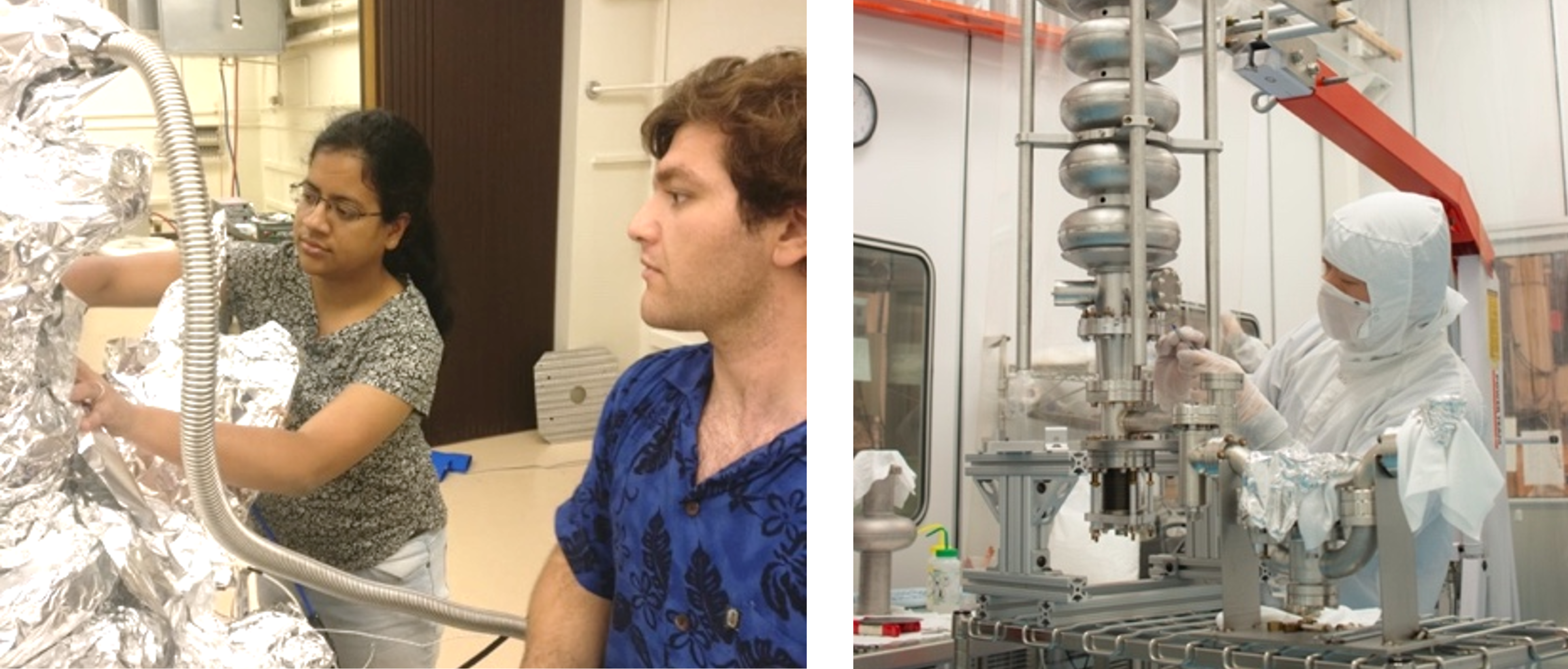 CBB research applies interdisciplinary expertise to the advancement of electron sources, superconducting devices for beam acceleration, and the application of machine learning to beam characterization and control. For example, CBB work on electron sources optimizes the design and growth of photocathodes, and its work on accelerating structures seeks superconductors that can sustain high-accelerating gradients and operate at relatively high temperatures for better energy efficiency and easier operation. In both cases, CBB joins experts in surface chemistry, materials science, microscopy and beam phenomenology. The outcome has been a series of important advances and new emphasis on the emerging discipline of accelerator materials. Examples of CBB’s recent accomplishments in this area and others are illustrated in the research highlights below.
CBB research applies interdisciplinary expertise to the advancement of electron sources, superconducting devices for beam acceleration, and the application of machine learning to beam characterization and control. For example, CBB work on electron sources optimizes the design and growth of photocathodes, and its work on accelerating structures seeks superconductors that can sustain high-accelerating gradients and operate at relatively high temperatures for better energy efficiency and easier operation. In both cases, CBB joins experts in surface chemistry, materials science, microscopy and beam phenomenology. The outcome has been a series of important advances and new emphasis on the emerging discipline of accelerator materials. Examples of CBB’s recent accomplishments in this area and others are illustrated in the research highlights below.
Cohort Building
To foster cohesion, CBB welcomes new members by introducing them to its goals and culture of interdisciplinary collaboration. Students learn how to access information and resources and are introduced to our Handbook, which has been featured in the NIH Team Science Toolkit. At onboarding, students also meet center management and connect with their incoming cohort. Building a sense of belonging has proved particularly important for students at universities with small accelerator science programs.
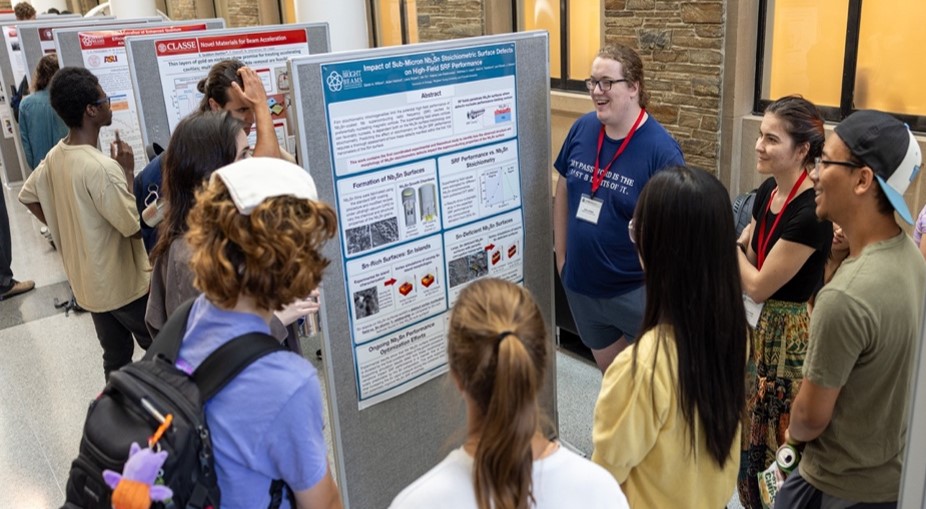 Poster Session at CBB Annual Meeting 2024
Poster Session at CBB Annual Meeting 2024
To provide a shared knowledge base, CBB created a comprehensive library of pedagogical videos, available on YouTube, addressing topics in accelerator physics and related materials science. Students further build their knowledge at grad-to-grad meetings where they can learn from one another, practice presentations and ask questions. Regular research meetings provide opportunities to present work, share insights and engage with peers. Presentations at these meetings always begin with a clear introduction to ensure that all participants, regardless of their field, can contribute meaningfully to discussions.
Professional Development and Communication
Comprehensive training prepares students for diverse careers in accelerator science and beyond. Each student completes a professional development plan with their faculty advisor, in which they identify their career aspirations and map out a personalized path to achieve those goals. To support these plans, CBB hosts workshops in areas such as research ethics, resume building and imposter syndrome. Many of the workshops build communication skills, such as George Gopen’s workshop on The Science of Scientific Writing, programs by the Alan Alda Center and workshops on grant writing, designing scientific graphics and interpersonal dialogue. Students develop elevator pitches for their research and frequently present at international scientific conferences and workshops. CBB students get hands-on training at university accelerator facilities and five have conducted thesis research at DOE laboratories thanks to Department of Energy’s Office of Science Graduate Student Research (SCGSR) awards.
The outcome of these efforts is that students report high satisfaction with their research experience (4.8 on a scale of 5) and professional development (4.4), and rate CBB well for diversity and equality (4.3). An unanticipated outcome is that the team has become remarkably diverse. Roughly 28% of our alumni are women or members of minoritized groups. While not yet representative of the population, this figure exceeds the diversity seen in physics as a whole and highlights the inclusive environment fostered by a collaborative approach.
The insets below illustrate some of CBB’s recent achievements and the teams who led them. Graduate students and postdocs played a vital role in the success of each one.
Web Page: https://cbb.cornell.edu
LinkedIn: https://www.linkedin.com/company/brightbeams
YouTube: https://www.youtube.com/channel/UCLLGLeOr-UUnws3RxbTK1NQ
Pedagogy: Introduction to Accelerator Sciences and Related Fields: https://www.youtube.com/playlist?list=PLHtN9nbbLM3cSxywU82NUG3uxCoD5x0BE
Publications: https://cbb.cornell.edu/publications
Research Highlights:
Understanding the growth of atomically ordered alkali-antimonide photocathode films
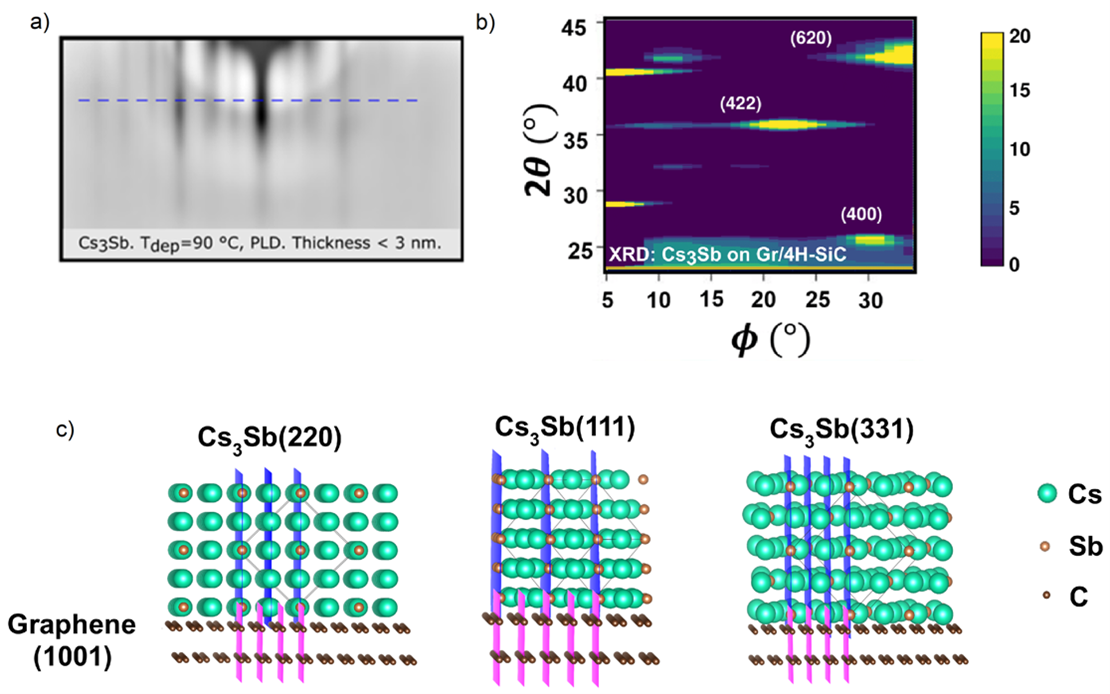 (a) RHEED pattern of the Cs3Sb film. Distances between reflection peaks were used to calculate the corresponding d-spacing. (b) The X-ray diffraction peaks as a function of azimuth angle. Both RHEED and XRD show peaks corresponding to Miller indices (400), (422) and (620). (c) Schematics of probable orientations that could result in epitaxy between the film and substrate with matching lattice-plane periodicity between Cs3Sb (blue) graphene (purple) and with corresponding unit cells (black lines).
(a) RHEED pattern of the Cs3Sb film. Distances between reflection peaks were used to calculate the corresponding d-spacing. (b) The X-ray diffraction peaks as a function of azimuth angle. Both RHEED and XRD show peaks corresponding to Miller indices (400), (422) and (620). (c) Schematics of probable orientations that could result in epitaxy between the film and substrate with matching lattice-plane periodicity between Cs3Sb (blue) graphene (purple) and with corresponding unit cells (black lines).
Ordered alkali antimonide photocathodes are emerging as a promising platform for producing high-brightness electron beams. Building on previous demonstrations of single crystal Cs₃Sb growth on 3C-SiC (001) using molecular beam epitaxy (MBE), we further explore this study by growing highly ordered Cs₃Sb films on graphene-coated 4H-SiC (0001) and 3C-SiC (001) substrates at the National Synchrotron Light Source II (NSLS-II) at Brookhaven National Laboratory using an innovative pulsed laser deposition (PLD) method. Operando diagnostics, including X-ray diffraction (XRD) and reflection high-energy electron diffraction (RHEED), reveal that films grown on graphene exhibit highly ordered domains consisting of crystallites, with Laue oscillations around Bragg peaks further highlighting their ordered structure (see Figure). Additionally, tensile strain release in thicker films grown on graphene suggests a potential epitaxial relationship between the film and substrate at lower thicknesses. The films exhibit high quantum efficiency (QE) given their relatively low thicknesses, with QE values at approximately one percent when illuminated by 532 nm light. This work demonstrates a valuable step toward high brightness alkali antimonides through ordering of the material structure, in addition to the in-vacuum structural analyses of thin films that become possible by utilizing both RHEED and XRD.
C. Pennington, M. Gaowei, E. M. Echeverria, K. Evans-Lutterodt, A. Galdi, T. Juffmann, S. Karkare, J. Maxson, S. J. van der Molen, P. Saha, J. Smedley, W. G. Stam and R. M. Tromp, “A structural analysis of ordered Cs3Sb films grown on single crystal graphene and silicon carbide substrates.” arXiv, Jul. 16, 2024. http://arxiv.org/abs/2407.12224
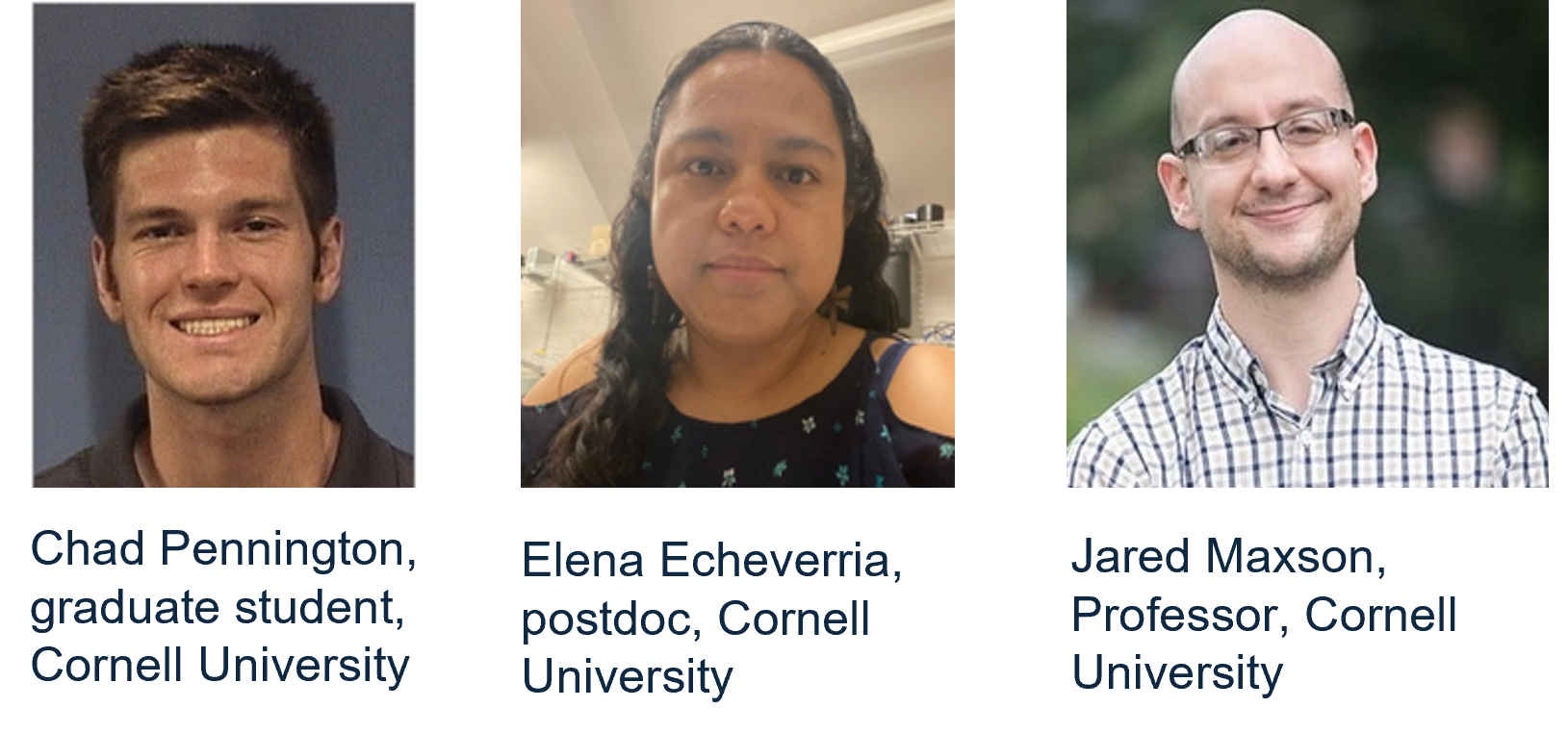
...
...
Revolutionizing Electron Sources with Plasmonic Interference
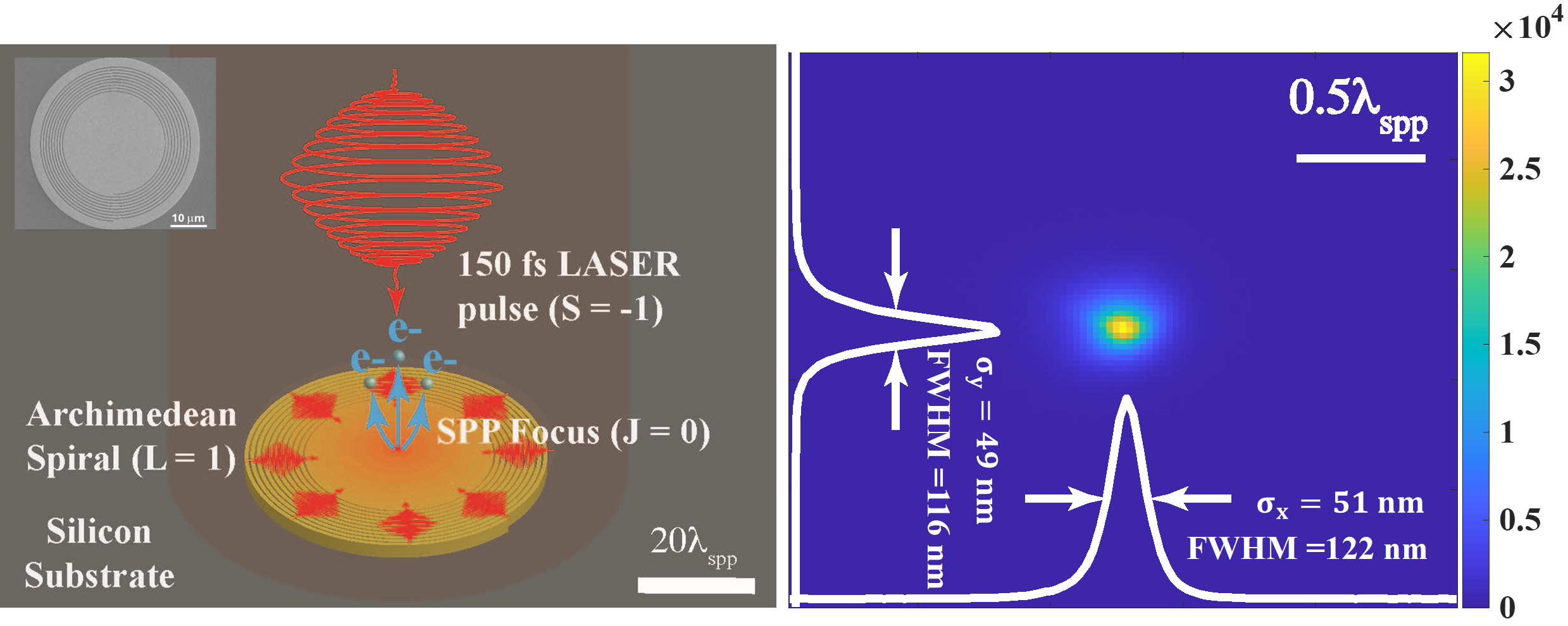 (left): A gold Archimedean spiral acts as a nanoscale electron source. When illuminated by a circularly polarized laser, it excites surface waves (red ripples) called surface plasmon polaritons (SPPs). These waves constructively interfere at the spiral’s center, amplifying energy and resulting in a nanoscale electron emission area. The setup demonstrates the interplay of light and nanoscale structures to generate nanoscale electron emission area. The inset shows the scanning electron microscope image of the fabricated gold Archimedean spiral photocathode
(left): A gold Archimedean spiral acts as a nanoscale electron source. When illuminated by a circularly polarized laser, it excites surface waves (red ripples) called surface plasmon polaritons (SPPs). These waves constructively interfere at the spiral’s center, amplifying energy and resulting in a nanoscale electron emission area. The setup demonstrates the interplay of light and nanoscale structures to generate nanoscale electron emission area. The inset shows the scanning electron microscope image of the fabricated gold Archimedean spiral photocathode
(right): The electron emission pattern from the center of the gold spiral, captured using photoemission electron microscopy (PEEM). The false-color scale reveals areas of varying intensity, showcasing the nanoscale electron emission area achieved by the spiral under laser illumination. Reprinted figure with permission from A. Kachwala, M. M. Rizi, C. M. Pierce, D. Filippetto, J. Maxson, and S. Karkare, Phys. Rev. Lett. 133, 185001, Copyright 2024 by the American Physical Society.
In a groundbreaking advance, plasmonic interference has been harnessed to achieve a record low emittance of under 40 pm-rad rms from a geometrically flat metal photocathode. This innovation, utilizing plasmonic focusing to reduce the electron emission area to below 50 nm, marks a major leap forward for ultrafast electron diffraction and microscopy (UED/M) and other electron beam-based instruments.
Traditionally, efforts to minimize emittance, which is crucial for high-resolution imaging and accelerator operations, focused on reducing the momentum spread of emitted electrons. However, the emission area remained limited by the diffraction limit. This new approach surpasses those limitations by reducing the emission area by more than an order of magnitude, paving the way for enhanced precision in UED/M and related fields.
Beyond improving beam emittance, this research opens new possibilities in electron beam structuring. The ability to pattern beams transversely at the nanoscale using plasmonics at the cathode could revolutionize advanced accelerator applications and coherent x-ray generation.
A. Kachwala, M. M. Rizi, C. M. Pierce, D. Filippetto, J. Maxson, and S. Karkare, “Harnessing Plasmonic Interference for Nanoscale Ultrafast Electron Sources Phys. Rev. Lett. 133, 185001, https://journals.aps.org/prl/abstract/10.1103/PhysRevLett.133.185001
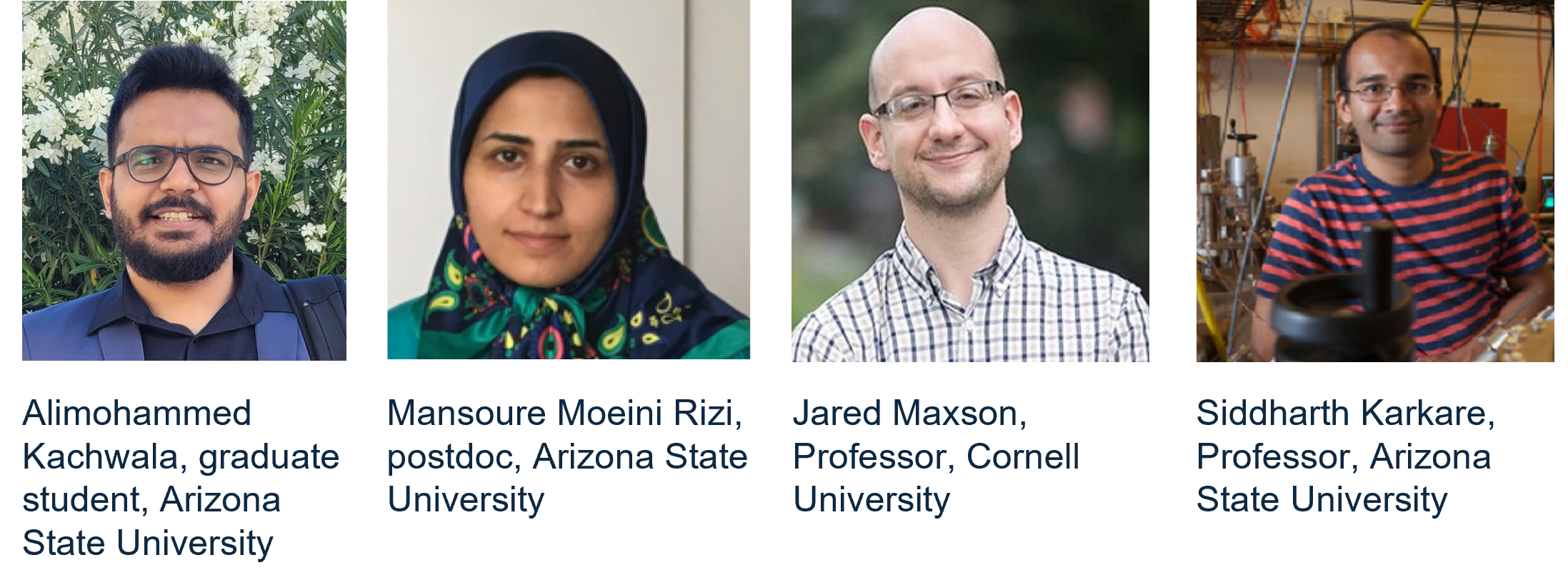
...
...
Relating Atomic-Scale Composition and Structure with Superconducting Properties via Helium Atom Scattering
Superconducting radio frequency (SRF) niobium cavities comprise the accelerating components of today’s linear particle accelerators. The goal for next-generation accelerators is to build higher performance SRF cavities using more highly perfected, doped, or alloyed materials to push the limits of operating temperatures and gradient fields. Several next-generation materials do not achieve their potential due to compositional inhomogeneities and structural defects. To overcome these challenges, it is crucial to correlate and understand how atomic-scale structure and composition influence superconducting properties. Low-energy neutral helium atom scattering (HAS) employing supersonic beams is a precise and surface-sensitive probe well matched to this challenge. HAS can probe atomic-scale surface structure and surface phonon band structure, and through recent theoretical developments, surface electron-phonon coupling (EPC). Surface EPC correlates with a variety of factors determining superconducting performance, including but not limited to, superconducting critical temperature and superheating field. We find that the (3x1)-O niobium surface oxide reconstruction has a surface EPC that is reduced to 40% of pure niobium’s surface EPC. These results were supported by the consistency between HAS measurements and ab initio density-functional theory predictions. This study not only confirms that the oxide has a deleterious effect on niobium’s superconducting performance, but it also paves the way to understand how a variety of specific atomic-scale features for candidate SRF materials like nitrogen-doped niobium and Nb3Sn quantitatively affect surface EPC.
C. J. Thompson, M. Van Duinen, C. Mendez, S. A. Willson, V. Do, T. A. Arias, and S. J. Sibener, “Distinguishing the Roles of Atomic-Scale Surface Structure and Chemical Composition in Electron Phonon Coupling of the Nb(100) Surface Oxide Reconstruction,” J. Phys. Chem. C, vol. 128, no. 25, pp. 10714–10722, Jun. 2024, doi: 10.1021/acs.jpcc.4c02430.
 Helium atoms scatter from the surface electron density of the (3x1)-O/Nb(100) surface reconstruction. Reprinted with permission from C. J. Thompson, M. Van Duinen, C. Mendez, S. A. Willson, V. Do, T. A. Arias, and S. J. Sibener, “Distinguishing the Roles of Atomic-Scale Surface Structure and Chemical Composition in Electron Phonon Coupling of the Nb(100) Surface Oxide Reconstruction,” J. Phys. Chem. C, vol. 128, no. 25, pp. 10714–10722, Jun. 2024. Copyright 2024 American Chemical Society."
Helium atoms scatter from the surface electron density of the (3x1)-O/Nb(100) surface reconstruction. Reprinted with permission from C. J. Thompson, M. Van Duinen, C. Mendez, S. A. Willson, V. Do, T. A. Arias, and S. J. Sibener, “Distinguishing the Roles of Atomic-Scale Surface Structure and Chemical Composition in Electron Phonon Coupling of the Nb(100) Surface Oxide Reconstruction,” J. Phys. Chem. C, vol. 128, no. 25, pp. 10714–10722, Jun. 2024. Copyright 2024 American Chemical Society."

...
...
Four-dimensional phase space reconstruction of flat and magnetized beams

2D projections of reconstructed 4D transverse phase space distributions for magnetized (left) and flat (right) beams at the Argonne Wakefield Accelerator. Units are mm for x and y coordinates, and mrad for x’ and y’ coordinates. Figure reproduced from Seongyeol Kim, et. al, Phys. Rev. Accel. Beams 27, 074601, 2024.
Flat and magnetized beams have become increasingly important in particle accelerators. For instance, flat beams can be used to increase luminosity for future colliders. On the other hand, magnetized electron beams can improve electron cooling performance in hadron beams. Characterizing these kinds of beams requires the full 4D transverse phase space distribution (TPS), which is usually time consuming and/or requires specialized diagnostics. In this work, our generative phase space reconstruction method (GPSR) was implemented to efficiently reconstruct the 4D TPS of flat and magnetized beams at the Argonne Wakefield Accelerator with a simple quadrupole scan and a YAG screen.
The figure shows the reconstructed 4D TPS for both the magnetized and flat beams. In both cases, the experimental data needed for the GPSR method consists of a few shots per step from an 11-step quadrupole scan. Magnetization values calculated from these reconstructed distributions were compared with traditional slit-mask measurements, showing good agreement within 10% error. Furthermore, x and y emittances were computed for the flat beam distribution and are in excellent agreement with conventional quadrupole scan measurements. These results show that GPSR can be used to reconstruct the 4D TPS distribution of flat and magnetized beams at the Argonne Wakefield Accelerator in an accurate and data-efficient way, leading to a more complete characterization of such beams.
S. Kim, J. P. Gonzalez-Aguilera, P. Piot, G. Chen, S. Doran, Y.-K. Kim, W. Liu, C. Whiteford, E. Wisniewski, A. Edelen, R. Roussel, and J. Power, “Four-dimensional phase-space reconstruction of flat and magnetized beams using neural networks and differentiable simulations,” Phys. Rev. Accel. Beams, vol. 27, no. 7, p. 074601, Jul. 2024, https://link.aps.org/doi/10.1103/PhysRevAccelBeams.27.074601
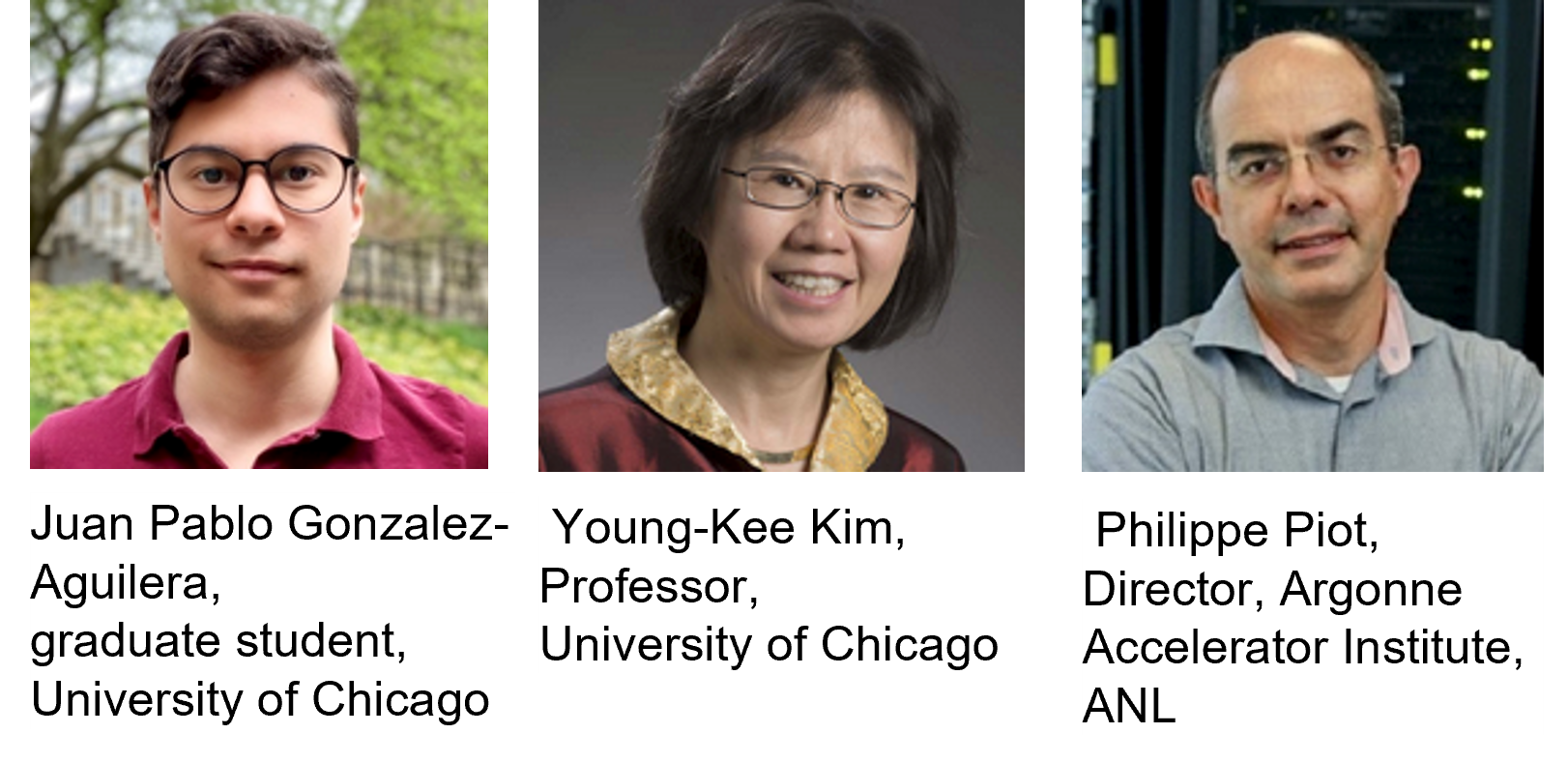
...
...
Physics-informed Bayesian Optimization of an Electron Microscope
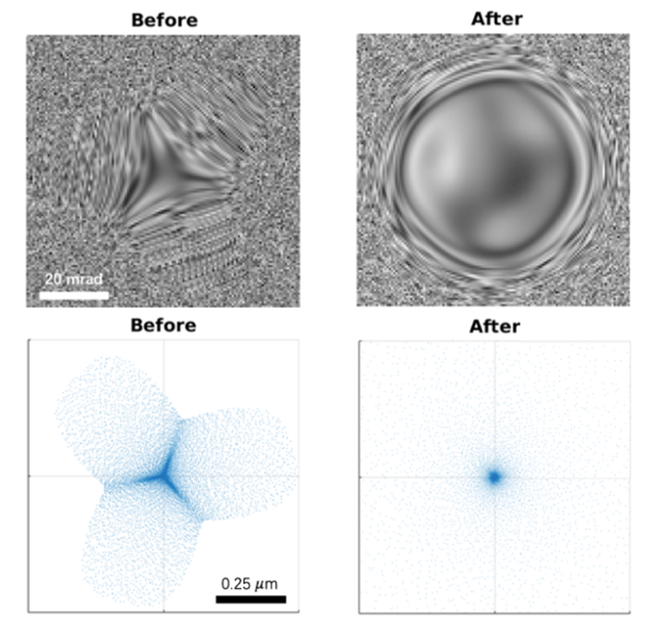 Bayesian optimization for alignment of an electron microscope. Top: Ronchigram showing the phase distribution of the beam in momentum space where a larger uniform region in the center indicates a better beam. Bottom: Modelled real space distribution of the electron beam showing better focusing after tuning. Figure reproduced from Desheng Ma et. al, Microscopy and Microanalysis, Volume 29, Issue Supplement_1, 1 August 2023, Pages 1875–1877, copyright Oxford University Press, 2023.
Bayesian optimization for alignment of an electron microscope. Top: Ronchigram showing the phase distribution of the beam in momentum space where a larger uniform region in the center indicates a better beam. Bottom: Modelled real space distribution of the electron beam showing better focusing after tuning. Figure reproduced from Desheng Ma et. al, Microscopy and Microanalysis, Volume 29, Issue Supplement_1, 1 August 2023, Pages 1875–1877, copyright Oxford University Press, 2023.
Achieving sub-Angstrom resolution by aberration correction in an electron microscope requires the precise control of a large set of multipole electron-optical elements very similar to those used in synchrotron ring, with similar challenges in their multidimensional optimization. We approach this challenge by recognizing the equivalence between aberration correction in electron microscopy and phase space beam emittance minimization in accelerator physics. We show that emittance (the volume of phase space occupied by the beam) as an alternate metric of beam quality is better behaved than the aberration function traditionally used in electron microscopy, which suffers from cusp-like minima that are very unstable.
We diagnose the lens distortions using electron Ronchigrams, which are diffraction patterns of a convergent electron beam focused on an amorphous material that encode the phase variation of the electron beam in momentum space and should be smooth when the microscope is properly tuned. We show a convolutional neural network (CNN) can be trained to predict beam emittance growth directly from single Ronchigrams, providing a bounded metric that enable Bayesian optimization (BO) for the autonomous aberration correction of the microscope.
Our approach enables new ways to quickly quantify and automate aberration correction that takes advantage of the rapid measurements possible with high-speed electron cameras. We have implemented the optimization method on a range of commercial electron microscopes. Tuning is rapid, taking less than several minutes, and gives results as good as the current hand-tuning, and requires no operator experience.
CBB is now applying these techniques to higher orders of aberrations. Once this is done, the goal is to transfer these methods to microscope companies, so that future microscopes can be automatically tuned, and users can avoid expensive and time-consuming visits by company experts.
Desheng Ma, Chenyu Zhang, Yu-Tsun Shao, Zhaslan Baraissov, Cameron Duncan, Adi Hanuka, Auralee Edelen, Jared Maxon, David Muller, Physics-informed Bayesian Optimization of an Electron Microscope, Microscopy and Microanalysis, Volume 29, Issue Supplement_1, 1 August 2023, Pages 1875–1877, https://doi.org/10.1093/micmic/ozad067.968
Chenyu Zhang, Zhaslan Baraissov, Cameron Duncan, Adi Hanuka, Auralee Edelen, Jared Maxson, David Muller, Aberration Corrector Tuning with Machine-Learning-Based Emittance Measurements and Bayesian Optimization, Microscopy and Microanalysis, Volume 27, Issue S1, 1 August 2021, Pages 810–812, https://doi.org/10.1017/S1431927621003214
Chenyu Zhang, Yu-Tsun Shao, Zhaslan Baraissov, Cameron J Duncan, Adi Hanuka, Auralee L Edelen, Jared M Maxson, David A Muller, Bayesian Optimization for Multi-dimensional Alignment: Tuning Aberration Correctors and Ptychographic Reconstructions, Microscopy and Microanalysis, Volume 28, Issue S1, 1 August 2022, Pages 3146–3148, https://doi.org/10.1017/S1431927622011692
